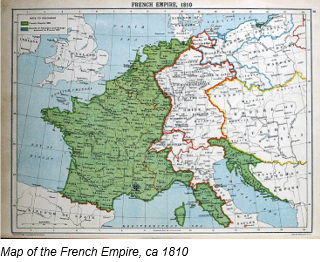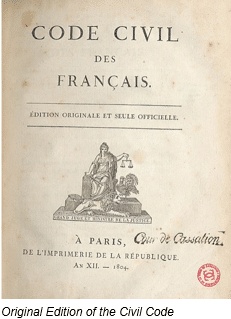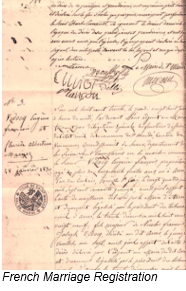Napoleonic-Era Civil Registration, Part 1
 11
11Jun
Napoleonic Code 
The Napoleonic Code was implemented in 1804, shortly after the French Revolution. This law code replaced the patchy feudal laws that had governed France during the Ancien Régime, or the old regime of monarchs. The Napoleonic Code, or the Code civil des Français encompassed all facets of the law, from criminal to civil. Civil registration of births, marriages, and deaths had begun in France in 1792 upon the dawn of the French Revolution, but was legally codified in 1804 under the Napoleonic Code. During the Revolution, established religion was largely decried and disenfranchised, so civil registration emerged to replace the recording of life events that was historically the responsibility of the Catholic Church. Indeed, under the Napoleonic Code, marriage was viewed solely as a civil contract.
As France expanded its imperial rule across much of Europe during the Napoleonic Wars (1803-1815), French officials implemented French civil law and code into its occupied territories. The Napoleonic Code was adopted by regions of Italy, regions of Germany, the Netherlands, Belgium, Poland, Spain, and Portugal, along with those nation’s respective colonial holdings.  Thus, all of these regions adopted Napoleonic forms of civil registration for births, marriages, and deaths. These forms were rife with details about these important life events, and have largely survived. In many instances, the government kept recording civil registration even after the end of French rule, so civil registration records persist throughout the nineteenth century and even into the twentieth century for many regions. Thus, they can provide a rich genealogical resource in documenting the lives of your French, Italian, German, Dutch, Belgian, Polish, Spanish, Portuguese, and Latin American ancestors.
Thus, all of these regions adopted Napoleonic forms of civil registration for births, marriages, and deaths. These forms were rife with details about these important life events, and have largely survived. In many instances, the government kept recording civil registration even after the end of French rule, so civil registration records persist throughout the nineteenth century and even into the twentieth century for many regions. Thus, they can provide a rich genealogical resource in documenting the lives of your French, Italian, German, Dutch, Belgian, Polish, Spanish, Portuguese, and Latin American ancestors.
Understanding Civil Registration Forms
The French implemented the exact same forms for civil registration in all of the regions discussed above, only making modifications in translating the forms to reflect the language of the region. The content and format of these civil registration records are remarkably consistent. The Code was very explicit in what needed to be recorded, when it needed to be recorded, and who needed to record. All of these factors make civil registration records extremely accurate and complete. For the researcher, this means that a civil registration form, whether it be in French, Dutch, or Polish contains the exact same information.
All forms of civil registration, whether that be birth, marriage or death, were to be recorded before the local civil register within several days of the event. The code specified who the informant should be- it varied by registration type. For the most part, civil registration was recorded on pre-printed forms, though in some regions the entire record was handwritten. However, the form and the handwritten records contain virtually the same information. The forms were then organized by type (birth, marriage, or death) and by year, and bound into volumes. These volumes are (for the most part) indexed alphabetically by surname. Duplicate forms and volumes were made: one was kept in the local town or village, while the other was sent to the jurisdictional court. The jurisdictional court can be found on the FamilySearch Wiki for a region.
Civil Registration of Births
The Napoleonic Code required that births be registered within three days of the birth, and that the child be presented to the civil officer. The birth of the child was to be reported by the child’s father, or in the case of illegitimacy or absence of the father, by the doctor or midwife who attended to the birth. Information required to be included on the birth record included:
- The day, hour, and place of the birth
- Sex and Christian name of the child
- Names of the parents (often including the mother’s maiden name), their profession, and their place of residence. Sometimes, the age of the parents is also included.
- Names of the witnesses (two were required), their profession, and their residence place.
- In cases of illegitimacy, often the name of the child’s father was given.
Civil Registration of Marriages
 Under the Napoleonic civil code, it was required that the intention of a couple to marry be published twice, with an interval of eight days between them, by the civil officer. This was meant to replace the publishing of the banns. The publication included the first and last names of those to be married, their professions, and residences, along with the names, professions, and residences of the couple’s parents. The publication was to be posted on the civil office for at least eight days.
Under the Napoleonic civil code, it was required that the intention of a couple to marry be published twice, with an interval of eight days between them, by the civil officer. This was meant to replace the publishing of the banns. The publication included the first and last names of those to be married, their professions, and residences, along with the names, professions, and residences of the couple’s parents. The publication was to be posted on the civil office for at least eight days.
Under the Civil Code, couples were to be married in the town hall by the civil officer, in the presence of four witnesses and their relations. However, in many cases the couple was married in the local church and then registered their marriage after at the town hall or civil office. Information included on the marriage record include:
- The first and last names, professions, ages, places of birth, and residences of the bride and groom
- If the bride and groom are of full age or are minors
- The first and last names, professions, and residences of the parents of the bride and groom
- The consent of the the parents in cases of minority
- When the publications were made
- The consent of the couple to take each other as husband and wife
- The names, ages, professions, and residences of the witnesses, and if they are relations to the couple
Civil Registration of Deaths
The deceased were not allowed to be buried until their death had been registered before the civil officer. Death registration was drafted by the officer upon the word of two witnesses reporting the death. If possible, these two witnesses were to be the two nearest relations or neighbors of the deceased. Information included on the death record include:
- The first and last name, age, profession, and residence at death of the deceased
- The first and last name of the deceased’s spouse, and if that spouse is living or dead
- The first and last names, ages, professions, and residences of the witnesses
- The first and last names, professions, and residences of the father and mother of the deceased
- The birthplace of the deceased
By understanding the content of the records, it will be much easier to understand the information being presented on civil registration records for births, marriages, and deaths. Civil registration provides fantastic details, details which can be crucial in documenting an ancestor’s life and expanding their family lines. The information contained on civil registration records are virtually the same for the different regions discussed above. Part two of this blog post will discuss the recording of civil registration region by region.
Price Genealogy’s professional researchers are very skilled in using and understanding these records. We can read them in their various languages. We are happy to assist you discover your ancestors!
By Kaitlyn
Have you ever had to do ancestry work with the Napoleonic code before? Let me know in a comment below!
